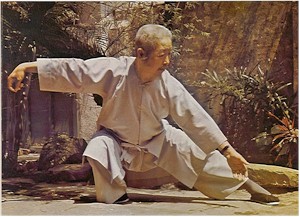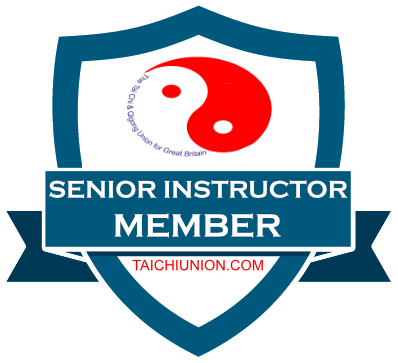Cheng Man Ching
Who is Cheng Man Ching
Of all the modern Tai Chi masters, none have had the impact of the late Cheng Man-Ching. As a child growing up in China, Cheng suffered from a chronic lung condition and a local doctor suggested that he take up Tai Chi to remediate his condition. Cheng proved so good a student that he not only learned Tai Chi, he also cured himself of his illness through his practice.
In many ways Cheng was a prodigy. He grew up to become renowned in his own country as a master of the "Five Excellences": painting, poetry, calligraphy, medicine and martial arts. When one considers the vast learning and diligent study it takes to master even one of these disciplines, Cheng's achievement becomes even more remarkable. His skill as a physician was said to be particularly uncanny and it is in this capacity that he was brought to the attention of Yang Ch'eng-Fu, the standard bearer and lineage heir to the great Yang Lu-Chan, founder of the Yang Family Style of Tai Chi. It seems that Yang's wife was extremely ill and the most prominent doctors had had little success trying to find a cure for her illness. Yang had heard of Cheng's reputation as a doctor and he agreed to examine her. Cheng was able to successfully restore MadameYang to health and in gratitude, Mrs. Yang persuaded her husband to accept him as a Tai Chi student. Cheng studied daily with Master Yang for years, enduring many hardships to learn the art. Although he later rose to become a great master of Tai Chi himself, Cheng, in typical modesty, always denigrated his own skill with respect to his teacher's. "If Tai Chi was a human body," he was fond of saying, "all I possess is the thumb. My teacher (Master Yang) has the whole body!" No small praise from this highly accomplished individual.
After an illustrious career as a physician, senator and martial artist in Taiwan, Professor Cheng emigrated to the U.S. where he ran a large Tai Chi School in New York's Chinatown section. Much to the detriment of us all, the old master departed this life on March 26th 1975, but his legacy lives on through his poetry, his painting, those he healed and those he taught.
| Dates | Accomplishments |
|---|---|
| 1901 | Born in Yungchia, in the Province of Chekiang. |
| 1911-13 | Studied painting with Prof. Wang Hsiang-Ch'ian who named the Professor's studio the “Wisteria Flower Studio”. |
| 1913-15 | Studied painting with well known artist, aunty Chang Kwong-Hong in Shanghai. |
| 1916 | Moved to Hangchou. Studied painting, poetry, and calligraphy with Shen Mei-So, Ma Yi-Fu, Ching Tzu-Yuan, Lo Hsing-Hu, Wang Ch'ien Lo, and others |
| 1919-23 | Moved to Peking. Published Ch'ang-he style of poetry with Lo Fu-Kan and Lo Ying-Kung. |
| 1920 | Taught poetry at Yu-Wen University. |
| 1922 | Professor of Chinese Ink Painting at the Peking Academy of Fine Arts. |
| 1925 | Taught at National Chi-Nan University and served as Director of painting Department of Shanghai School of Fine Arts. |
| 1926-28 | Formed Chinese Herbal Medicine Doctor's Society as Chairman Director. Became a student of Tang, Sung, Yuan, Ming, and Ch'ing Dynasties medicine with Dr. Sung You-an. Additionally, he achieved mastery of traditional gynecology, and orthopedic medicine. |
| 1928-1935 | Studied T'ai Chi Ch'uan with Yang Cheng-Fu. |
| 1930 | Founded the College of Chinese Culture and Arts and served as vice-president to the college. |
| 1931-33 | Retired from teaching and moved to Yang-Hu where he studied with Master teacher of classics Ch'ien Ming-Shan |
| 1933 | Taught T'ai Chi Ch'uan at Central Military Academy. |
| 1936 | Began practicing medicine full time. |
| 1938 | Consultant to Hunan Provincial Government and Director of Martial Arts for Hunan Province. |
| 1938 | Condensed the T'ai Chi Ch'uan solo exercise to 37 postures in Hunan. |
| 1939 | Taught T'ai Chi Ch'uan at the Military Training Group in Chung King. |
| 1941 | Took the name “Man-Ching” and married Ms. Yi-Tu. |
| 1946 | Member of the National Assembly for the construction of the Constitution for the Republic of China. |
| 1947 | Representative for the Community of Doctors of Chinese Medicine to the National Assembly. |
| 1949 | Moved to Taiwan and formed the Shr Jung School of T'ai-Chi Ch'uan. |
| 1950 | Formed the Poetry Society with Yu You-Jen, Ch'en Han-Kuang, Chang Chao-Ch'in, Ma Shao-Wen, Chang Ching-Wei, and others. |
| 1950-1963 | Private instructor of painting, students include Madam Chiang Kai-Shek. |
| 1951-64 | Formed the seven Friends of Painting and calligraphy with Ma shou-Hua, T'ao Yun-Lo, Chen Fang, Chang Ku-Nien, Liu Yen-T'ao, and Kao Yi-Hung. Helped to form the Republic of China Fine Arts Society, served as an officer and head of the Chinese Painting and Calligraphy Exhibition. Held a lifetime professorship at the College of Chinese Culture. Director of Fine Arts, The Republic of China Cultural Renaissance Movement, American branch. Held many one man painting exhibitions, including the 1964 exhibits at the National Cernushi Gallery in Paris and the World's Fair in New York. |
| 1964 | founded the Shr Jung Center for the Cultural Arts in New York. |
| 1964 | Established T'ai Chi Institute in NY. |
| 1973 | Formed the Shr Jung T'ai Chi Center in Yew York |
| 1974 | Returned to Taiwan to publish Yi Ch'uan. |
| 1975 | March 26, at midnight, he died. |
| This translation was done in the presence of Mrs. Cheng as she transliterated the wen yen of Professor Cheng's funerary book into pai hua so that I could understand it. (Tam Gibbs) Corrected and added to by Katy Cheng, April 2000 |
|


